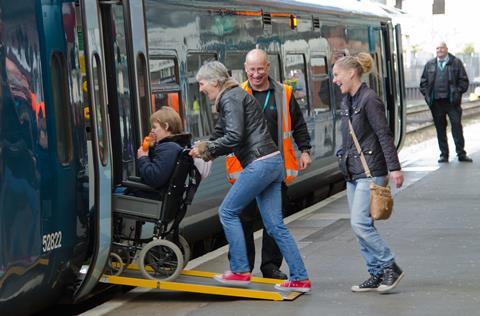
UK: The time to required to book Passenger Assist services such as help with navigating a station or boarding a train has been reduced from 6 h to a minimum standard of 2 h ahead of travel. However, campaigners have expressed concern at the slow pace of works to enable all passengers to get from the street to the train unassisted.
The Rail Delivery Group reports that train operators provided over 51 500 assistances for journeys booked more than 2 h ahead during the first three weeks after booking times were reduced on April 1, and 4 700 assistances for journeys booked with less than 2 h notice.
The Passenger Assistance by Transreport app was launched last year to speed the process of requesting assistance, and people can also book assistance by phone, text phone or online.
Operators are also required to make every effort to assist people who turn up and go without booking assistance in advance.
However, user groups have expressed concern at suggestions DfT is keen to reduce on-train and station staff to save costs.
Transport for All recently said ‘widely reported new government plans could result in mass closure of ticket offices. This risks creating further barriers for disabled and older passengers, for whom staff at ticket offices are often the first point of contact for assistance’.
A consultation by Transport Focus saw 99% of 1 500 respondents expressing their opposition to ticket office closures, with accessibility issues being among the major worries.
Research has shown that 17% of rail passengers have a mobility issue, and the white paper outlining the Williams-Shapps Plan for Rail proposes creating a statutory duty for Great British Railways to implement a national strategy to improve accessibility.
Some £500m has been spent on accessible routes, including step-free access, at more than 200 stations, with a further 1 500 stations benefitting from smaller-scale improvements, but with 2 570 stations on the network there is still much more work required.
A 2014 standard which specifies a platform height 915 mm above the rails and a horizontal distance between the rails and platform edge of 730 mm is met at just 7% of stations.
Ensuring all stations are fully compliant with step-free and assistance-free access from the street to the train will require very significant investment, but campaigners note that many stations could be improved at a relatively low cost and are calling for a new round of funding for these ‘easy targets’ alongside the programme of more significant work where lifts and other major changes are required.



